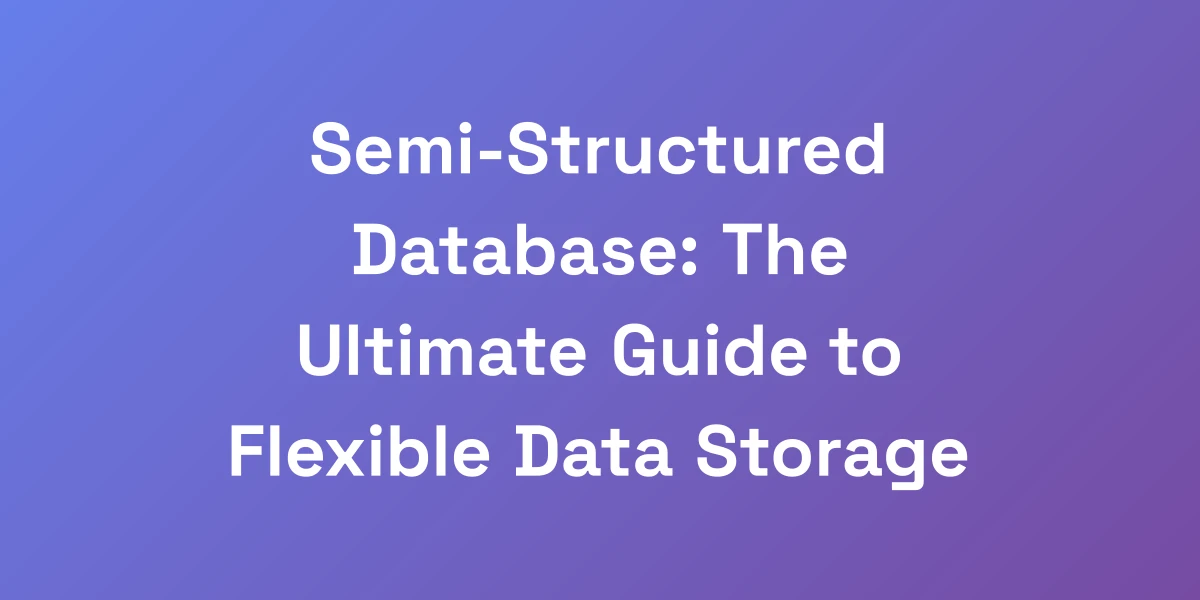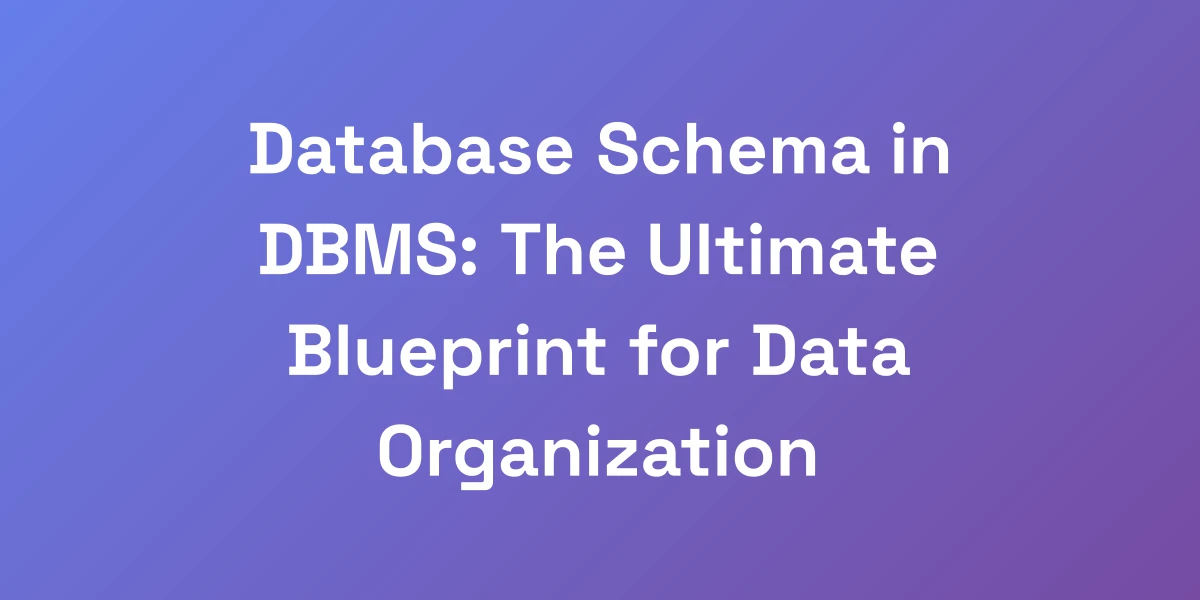
Semi-Structured Database: The Ultimate Guide to Flexible Data Storage
Mar 12, 2025 | By [email protected]
Understanding Semi-Structured Databases: Breaking Free from Rigid Schemas
Listen, here’s the raw truth about data that nobody’s telling you: the world isn’t black and white, and neither is your data.
Semi-structured databases are the game-changers that bridge the gap between rigid traditional databases and complete chaos. They’re like the entrepreneurs of the data world – flexible enough to adapt, yet organized enough to scale.
I’ve seen countless businesses transform their operations by embracing this hybrid approach, and I’m going to show you exactly why it’s becoming the secret weapon in modern data architecture.
Why stick with outdated systems that can’t keep up with your dynamic needs? The challenges of managing diverse data types and scaling efficiently are real, but semi-structured databases offer a robust solution that traditional databases simply can’t match.
Ready to break free from the shackles of rigid schemas and unlock the full potential of your data? Let’s dive deep into the world of semi-structured databases and explore how they can revolutionize your data storage strategy.
The Evolution of Database Systems
Databases have come a long way from their inception. Initially, we had flat-file databases, which were simplistic and lacked the ability to handle complex data relationships. Then came the relational databases, which introduced structured schemas and powerful query capabilities. However, as data became more diverse and the need for flexibility grew, relational databases started showing their limitations.
Enter NoSQL databases, and within them, semi-structured databases carved out a niche by offering the best of both worlds. They maintain some structure but allow for flexibility, making them ideal for applications that require rapid scalability and adaptability.
Think about it: in the age of big data and real-time analytics, having a database that can evolve with your data without the overhead of constantly redefining schemas is invaluable.
Core Characteristics of Semi-Structured Data
Semi-structured data sits between structured and unstructured data. It doesn’t fit neatly into tables like relational data, but it retains some organizational properties that make it easier to analyze than raw unstructured data.
- Flexible Schema: Unlike traditional databases, semi-structured databases don’t require a fixed schema. This means you can add new fields or data types without disrupting existing data.
- Hierarchical Data Format: Data is often stored in formats like JSON or XML, which inherently support nested structures, making it easier to represent complex relationships.
- Schema-on-Read: Instead of enforcing a schema when writing data, it’s applied when reading it, providing greater flexibility in how data is stored and accessed.
- Self-describing Data: Each data element carries information about its structure and meaning, which simplifies data parsing and processing.
Key Differences from Traditional Databases
Understanding the differences between semi-structured and traditional databases is crucial for making informed decisions about your data architecture.
- Schema Flexibility: Traditional databases enforce a rigid schema, requiring predefined tables and columns. Semi-structured databases allow for dynamic schemas, accommodating varying data types and structures.
- Scalability: Semi-structured databases are designed to scale horizontally, making it easier to handle large volumes of data by distributing it across multiple servers. According to a 2023 Cloud Data Platform Benchmark and Analysis, this scalability is a key advantage in modern data management.
- Data Representation: While traditional databases use tables, semi-structured databases often use documents or key-value pairs, which can naturally represent hierarchical data.
- Query Language: Traditional databases use SQL, a powerful but rigid query language. Semi-structured databases might use more flexible query languages or APIs tailored to their data models.
The Business Value Proposition
Semi-structured databases aren’t just a technical upgrade; they’re a strategic asset for businesses looking to leverage data more effectively.
- Agility: The ability to adapt your data model on the fly means quicker iterations and faster response to market changes.
- Cost Efficiency: With their horizontal scalability, semi-structured databases can reduce infrastructure costs by leveraging commodity hardware and cloud services.
- Enhanced Data Integration: They simplify the integration of diverse data sources, enabling a more comprehensive view of your business operations. This includes integrating SEO optimization automation tools to streamline your marketing efforts.
- Improved Performance: Optimized for specific use cases like real-time analytics, semi-structured databases can deliver faster query responses and better performance under heavy loads.
According to a recent Data Warehousing Market report, the adoption of semi-structured databases is on the rise, driven by their ability to handle complex and varied data efficiently.
Real-World Applications and Use Cases
From streaming services to e-commerce, semi-structured databases power some of the most dynamic applications in the market.
- Netflix and MongoDB: Netflix leverages MongoDB to manage user profiles and preferences, allowing for personalized content recommendations at scale.
- Amazon DynamoDB: Many of Amazon’s services use DynamoDB to handle high-traffic applications that require low-latency data access and seamless scalability.
- IoT Data Management: With the explosion of IoT devices, semi-structured databases store vast amounts of sensor data, facilitating real-time analytics and monitoring.
- Content Management Systems: Platforms like WordPress use semi-structured databases to manage diverse content types, from blog posts to multimedia assets, including autoblogging solutions to streamline content creation.
The Architecture and Components of Semi-Structured Databases
Let me break this down in a way that actually matters to your bottom line. Semi-structured database architecture isn’t just about storing data differently – it’s about unlocking possibilities that traditional systems can’t touch.
Think about it: every time you’ve been told “that’s impossible” by your database team, it’s probably because they’re stuck in the old paradigm. The beauty of semi-structured systems lies in their adaptive schema design and flexible data modeling. This isn’t just theory – it’s the difference between scaling to $100M and hitting a technical ceiling at $10M.
Schema-Less Design Principles
Semi-structured databases embrace a schema-less design, allowing each record to have a different structure. This flexibility is achieved through document-based or key-value data models.
- Document-Oriented Storage: Data is stored in documents, typically JSON or BSON, which can nest other documents or arrays, representing complex relationships naturally.
- Dynamic Fields: New fields can be added without altering existing records, making it easy to evolve your data model as your application grows.
- Polymorphism: Records can vary in structure, enabling the storage of different types of data within the same collection or table.
Actionable Tip: When designing your semi-structured database, start by identifying the core entities and their possible variations. Use this to structure your documents in a way that maximizes flexibility while maintaining some level of consistency.
Data Organization and Hierarchy
The way data is organized and hierarchical structures are managed is crucial for performance and scalability.
- Nested Structures: Semi-structured databases allow for nested data, which can reduce the need for complex joins and improve query performance. Efficient processing techniques for JSON and Parquet semi-structured data can further optimize this process.
- Indexing: Effective indexing strategies, including nested and compound indexes, enhance data retrieval speeds.
- Partitioning: Data is often partitioned based on certain criteria, such as geographic location or user ID, to distribute load and improve access times.
Real-World Example: Amazon DynamoDB uses partition keys to distribute data across multiple servers, ensuring that data access remains fast even as your dataset grows exponentially.
Storage Mechanisms and Indexing
Efficient storage mechanisms and indexing are the backbone of any high-performance database system.
- Columnar Storage: Some semi-structured databases use columnar storage to optimize read operations for specific queries.
- Secondary Indexes: These indexes allow for faster searches on fields that aren’t part of the primary key, enhancing query flexibility.
- Full-Text Search: Built-in support for full-text search enables efficient querying of large text fields without compromising performance.
Actionable Tip: Leverage indexing features judiciously. While indexes speed up queries, they can slow down write operations. Strike a balance based on your application’s read-write patterns.
Query Processing and Optimization
How you query your data can significantly impact performance and resource utilization.
- Flexible Query Languages: Many semi-structured databases offer powerful and flexible query languages tailored to their data models.
- Query Optimization: Advanced query planners and optimizers ensure that your queries run as efficiently as possible.
- Aggregation Frameworks: Built-in aggregation tools allow for complex data processing directly within the database, reducing the need for external processing.
Case Study: MongoDB’s aggregation framework enables complex data transformations and analysis within the database, streamlining workflows and reducing latency.
Scalability Features
Scalability is one of the most significant advantages of semi-structured databases, ensuring that your data infrastructure can grow alongside your business.
- Horizontal Scalability: By distributing data across multiple nodes, semi-structured databases can handle increased loads without performance degradation.
- Auto-Scaling: Many cloud-based semi-structured databases offer auto-scaling features that automatically adjust resources based on demand.
- Replication and Fault Tolerance: Data replication across different nodes ensures high availability and resilience against failures.
Real-World Example: Amazon DynamoDB’s auto-scaling capabilities allow businesses to handle unpredictable traffic spikes effortlessly, ensuring consistent performance and reliability.
Implementation Strategies and Best Practices
Here’s the million-dollar secret about implementing semi-structured databases: it’s not about the technology, it’s about the strategy.
Most people fail because they try to force-fit old methodologies into new systems. I’ve personally guided dozens of implementations, and the winners all share one thing: they understand that success lies in embracing the inherent flexibility while maintaining just enough structure to prevent chaos.
Let me show you the exact framework that’s worked time and time again.
Choosing the Right Database Solution
Not all semi-structured databases are created equal. Selecting the right one depends on your specific needs and use cases.
- Assess Your Data Needs: Understand the types and volumes of data you’re dealing with. Are you handling large-scale IoT data, user-generated content, or real-time analytics?
- Evaluate Performance Requirements: Different databases excel in different areas. MongoDB is great for flexibility, while DynamoDB is ideal for high-performance applications.
- Consider Scalability and Growth: Choose a database that can grow with your business. Cloud-native options like Couchbase or Amazon DocumentDB offer seamless scalability.
Actionable Tip: Create a list of your primary requirements and match them against the strengths of various semi-structured databases. Don’t compromise on critical features that are essential for your application’s success.
Data Modeling Approaches
Effective data modeling is key to harnessing the full potential of semi-structured databases.
- Denormalization: Embrace denormalized data models to reduce the need for complex joins and improve query performance.
- Embedding vs. Referencing: Decide when to embed related data within documents and when to reference it externally based on access patterns and data relationships.
- Schema Design: Although schema-less, having a logical structure enhances data integrity and accessibility. Define conventions for naming fields and structuring documents.
Real-World Example: Stitch Fix uses MongoDB’s flexible schema to store customer preferences and style data, allowing dynamic adjustments without disrupting the overall data architecture.
Performance Optimization Techniques
Optimizing performance ensures that your semi-structured database operates efficiently under varying loads.
- Indexing Strategies: Implement appropriate indexing to speed up commonly used queries. Use compound indexes for queries that filter on multiple fields.
- Sharding: Distribute data across shards to balance the load and prevent any single node from becoming a bottleneck.
- Caching Mechanisms: Utilize caching to reduce read latency and offload frequent queries from the database.
Actionable Tip: Regularly monitor query performance and adjust your indexing and sharding strategies based on evolving access patterns and data growth. Additionally, incorporating auto SEO tools can automate the optimization of query structures for better performance.
Security Considerations
Security is paramount when handling data, regardless of the database type.
- Access Controls: Implement role-based access controls to ensure that only authorized users can access or modify data.
- Encryption: Use encryption for data at rest and in transit to protect sensitive information from unauthorized access.
- Regular Audits: Conduct regular security audits to identify and mitigate potential vulnerabilities.
Case Study: MongoDB’s comprehensive security features, including encryption and access controls, are leveraged by enterprises like eBay to safeguard their extensive datasets.
Migration Strategies
Migrating to a semi-structured database requires careful planning to ensure data integrity and minimize downtime.
- Data Assessment: Evaluate the existing data structures and identify how they map to the new semi-structured format.
- Incremental Migration: Transition data in phases to reduce risk and allow for testing at each stage.
- Backup and Recovery: Ensure you have robust backup and recovery plans in place to prevent data loss during migration.
Actionable Tip: Start with a small subset of your data to pilot the migration process. Use the insights gained to refine your approach before a full-scale rollout.
Monitoring and Maintenance
Ongoing monitoring and maintenance are essential to keep your semi-structured database running smoothly.
- Performance Monitoring: Use monitoring tools to track key performance metrics and identify potential bottlenecks.
- Regular Maintenance: Perform routine maintenance tasks such as index rebuilding and data archiving to sustain performance levels.
- Scalability Assessments: Periodically assess your scalability needs and adjust your infrastructure accordingly to handle growth.
Real-World Example: Amazon DynamoDB provides built-in monitoring tools that allow businesses to track performance metrics and automatically scale resources based on traffic patterns.
Advanced Features and Future Trends
If you want to stay ahead in the data game, you need to understand where this is all heading.
The future of semi-structured databases is not just about storing data differently – it’s about enabling entirely new business models.
We’re seeing AI integration, real-time analytics, and edge computing capabilities that were impossible with traditional systems. The companies that understand and leverage these advances are the ones that will dominate their markets in the next decade.
AI and Machine Learning Integration
The integration of AI and machine learning with semi-structured databases is transforming how businesses derive insights from data.
- Automated Data Processing: AI algorithms can automatically organize and process semi-structured data, uncovering patterns and trends without manual intervention.
- Predictive Analytics: Machine learning models can analyze semi-structured data to make accurate predictions, enhancing decision-making processes.
- Enhanced Search Capabilities: AI-powered search engines can understand and interpret complex queries, delivering more relevant results from semi-structured datasets.
Actionable Tip: Integrate AI tools with your semi-structured database to leverage automated insights and drive smarter business strategies.
Edge Computing Capabilities
As IoT devices proliferate, edge computing has become essential for processing data closer to its source.
- Low Latency: Processing data at the edge reduces latency, enabling real-time analytics and immediate response actions.
- Bandwidth Efficiency: By handling data locally, edge computing minimizes the need to transmit large volumes of data to central servers, saving bandwidth and reducing costs.
- Enhanced Security: Processing data locally can enhance security by limiting the amount of data transmitted over networks.
Real-World Example: Google Cloud’s Bigtable integrates seamlessly with edge computing platforms, allowing companies like Spotify to manage and analyze streaming data in real time.
Real-time Analytics
Real-time analytics is revolutionizing how businesses interact with their data, providing instant insights that drive immediate actions.
- Stream Processing: Semi-structured databases can handle continuous data streams, enabling real-time data processing and analysis.
- Dynamic Dashboards: Real-time data feeds power dynamic dashboards that offer up-to-the-minute insights into business operations.
- Immediate Decision-Making: With real-time analytics, businesses can make informed decisions on the fly, responding swiftly to changing market conditions.
Case Study: Netflix uses real-time analytics powered by semi-structured databases to monitor user behavior and adjust content recommendations instantly, enhancing user engagement and satisfaction.
Cloud-Native Features
Cloud-native databases are designed to take full advantage of cloud infrastructure, offering unparalleled flexibility and scalability.
- Elastic Scalability: Automatically scale resources up or down based on demand, ensuring optimal performance without manual intervention.
- Managed Services: Cloud providers offer managed database services that handle maintenance, updates, and backups, freeing up your team to focus on core business tasks.
- Global Availability: Cloud-native databases can be distributed globally, providing low-latency access to data from anywhere in the world.
Real-World Example: CockroachDB’s cloud-native architecture enables businesses to deploy globally distributed databases that offer high availability and resilience, critical for modern, distributed applications.
Emerging Use Cases
New use cases continue to emerge as semi-structured databases evolve, opening up innovative possibilities across various industries.
- Personalized Marketing: Leverage semi-structured data to create highly personalized marketing campaigns that resonate with individual customers through marketing automation for agencies solutions.
- Healthcare Analytics: Manage and analyze diverse healthcare data types, from patient records to medical images, to improve patient outcomes and operational efficiency.
- Financial Services: Use semi-structured databases to handle complex financial data, enabling advanced risk assessment and fraud detection.
Actionable Tip: Stay abreast of emerging use cases in your industry and explore how semi-structured databases can address specific challenges and unlock new opportunities.
Industry-Specific Innovations
Semi-structured databases are being tailored to meet the unique needs of various industries, driving specialized innovations.
- Retail: Enhance inventory management and customer relationship management by storing and analyzing diverse data types, from sales transactions to customer feedback.
- Media and Entertainment: Manage multimedia content efficiently, enabling seamless content delivery and interactive user experiences.
- Manufacturing: Optimize supply chain management and predictive maintenance by analyzing sensor data and operational metrics in real time.
Real-World Example: IBM’s tailored solutions for the retail industry leverage semi-structured databases to handle diverse product data and enhance customer engagement through personalized recommendations.
Conclusion
We’ve journeyed through the intricacies of semi-structured databases, uncovering how they break free from the constraints of traditional systems to offer unparalleled flexibility and scalability.
The key takeaways are clear: semi-structured databases provide the agility and adaptability that modern businesses need to thrive in a data-driven world. From their flexible schema design to their robust performance and scalability features, they empower organizations to handle diverse data types and scale effortlessly.
Ready to take your data storage strategy to the next level? Embrace semi-structured databases and unlock the full potential of your data. Whether you’re managing vast amounts of IoT data, implementing content marketing for small businesses, personalizing user experiences, or driving real-time analytics, semi-structured databases offer the tools and flexibility you need to succeed.
Don’t let outdated systems hold you back. Take action today and transform your data architecture with semi-structured databases. Have questions or experiences to share? Drop a comment below and join the conversation. Let’s push the boundaries of what’s possible together.








